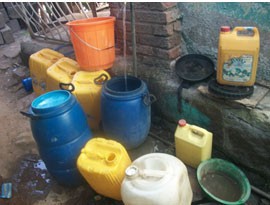Methods of safe household water collection
Households in urban areas that do not have a tap connection in their house or yard will probably collect water from a water point or kiosk. Even where there is a household connection, residents may sometimes need to use other sources, for example if there is a break in supply. In longer-term emergency situations, safe water may be delivered by tanker to residential areas for distribution to householders. In both of these instances, collection vessels such as those shown in Figure 10.1 will be used to carry water to the home.

Figure 10.1 Commonly used water collection vessels.
A water container has to be clean, and must not previously have been used to contain any toxic material (such as pesticides). Ideally, the mouth of the vessel should be narrow and it should have a lid. It should have handles so that it can be carried easily.
Why is it better to have a container with a narrow opening?
This reduces the chances of contamination because less of the water is exposed. Most importantly, people will not be able to put their hands into the water, which is one of the most likely sources of contamination.
An alternative to the containers shown in Figure 10.1 is the Hippo Water Roller (Figure 10.2), which enables water to be transported more easily and efficiently. It is a 90-litre drum made from UV-stabilised, low-density polyethylene that can be rolled along the ground using a steel clip-on handle. The device is designed to cope with rough surfaces and is very stable in the upright position. The roller is rounded at the shoulders and has hand grips at the top and bottom to make it easier to tilt a full roller when pouring.

Figure 10.2 Hippo Water Rollers in use.